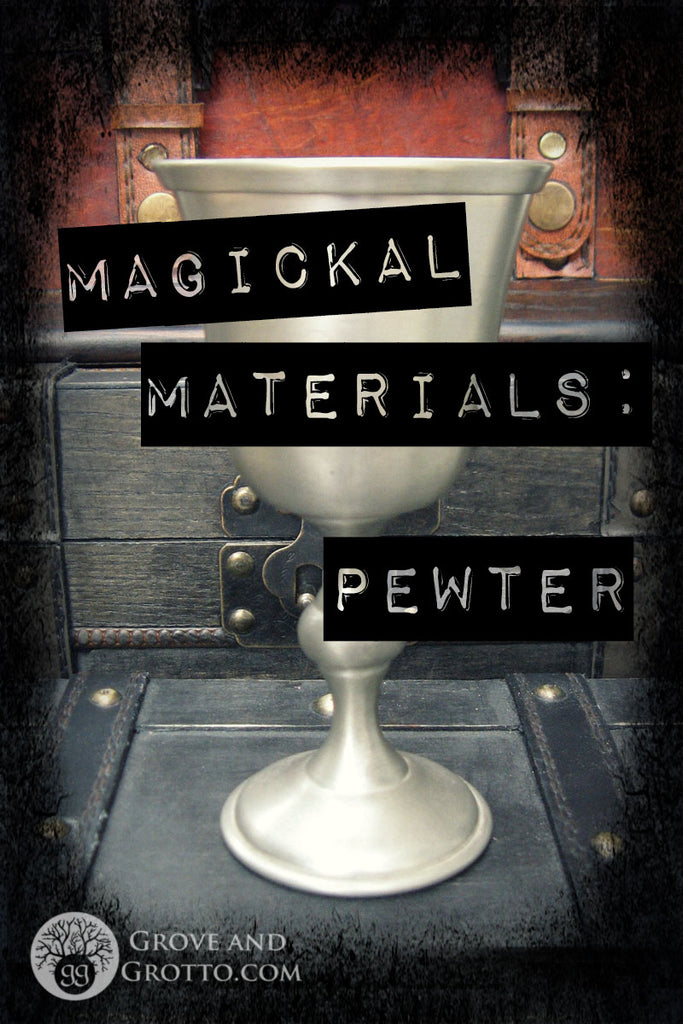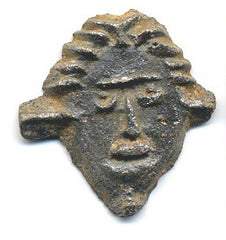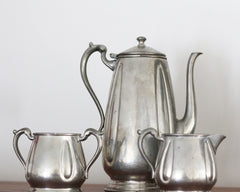Magickal materials: Pewter
Posted by Michelle Gruben on

Pewter is a popular material for ritual items, including amulets, chalices, and wands. You’ve probably seen it cast in various designs, from pentacles to dragons. It is a silver-colored metal with a pleasing weight and old-fashioned look.
But choosing magickal items encompasses more than just look and feel. As magick workers, we’re aware that every type of matter has its own energetic properties. Learning more about the properties of each material can help you choose the right tool for the job. Metals and gems especially have been connected through folklore with special powers and properties.
Most magicians will be familiar with the Seven Alchemical Metals: Gold, Silver, Mercury, Copper, Iron, Tin, and Lead. To medieval alchemists, these metals represented pure principles connected to the seven planets of the ancients. All of these materials have something in common: They are basic elements, each made up of one type of atom. A metal made up of more than one element is called an alloy. (Bronze and pewter are two of the best-known metal alloys.)
What is pewter?
Pewter is, by its simplest definition, an alloy of tin. Tin is the predominant ingredient, usually making up between 85 and 97 percent of the product. (Copper, bismuth, and antimony usually make up the balance.) Pure tin is very soft and white-ish, so other metals are added for hardness and color. A typical modern casting of high-quality pewter might contain 94% tin, 1% copper, and 5% bismuth.
The main ingredient in pewter (tin) is the alchemical metal of Jupiter. Pewter is an especially good choice for Jupiter workings—magick of luck, generosity, and influence.
History of pewter

Some people think of pewter as a relatively new metal, but that is not the case. The alloying of tin probably followed shortly after the alloying of copper. The earliest example of pewter comes from a Bronze Age site in Egypt. The Romans made many pewter items with tin mined in Britain. Pewter was also known to the Vikings. Many small pewter objects dating from the Medieval period have been unearthed in Britain and Europe.
Few 17th- and 18th-century European homes would have been without pewter. It was used extensively for tableware, jugs, candlesticks, and other household goods.
Does pewter contain lead?

Quality pewter made today is lead-free. But before the hazards of lead were widely known, many pewter castings did include lead. Lower grades of household pewter contained the most lead, and higher grades contained less.
The charm of vintage pewter is irresistible, but it’s best to exercise caution when purchasing old pewter chalices or candlesticks for your altar. Lead-containing pewter often has a blue-ish cast when new. It darkens when it ages and is difficult to restore to shine—hence the lower cost, historically, of leaded pewter. The safest way to determine if old pewter contains lead is to use a lead test kit. Leaded pewter should not be handled (especially by children) or used for food and drink.
Imported pewter is another cause for concern. In the United States, pewter items that come into regular direct contact with the body—such as drinking wares and jewelry—may not contain lead as an ingredient. But imported pewters can contain dangerous mixes of metals. Many inexpensive items sold as “pewter” don’t contain any tin at all, but are alloys of zinc, chromium—yes, lead.
Lead, incidentally, is also a planetary metal (of Saturn). But because it is toxic, lead is not recommended as a material for ritual tools.
Comparing pewter to silver
A lot of metaphysical shops present pewter as a cheaper alternative to sterling silver, but there’s more to it than that. These are two very different metals, and there are advantages and disadvantages to each.
Sterling silver is also an alloy (92.5% silver combined with 7.5% other metals). Sterling silver and pewter jewelry look very similar when new and polished. Some people say pewter is slightly duller and darker than shiny silver. Even so, it can be difficult to tell the difference.
The main practical advantages of pewter are its cost and resistance to tarnishing (see below). Silver’s value hovers around $15-20 per ounce—not astronomical, but expensive enough to make large silver altar tools impractical for most people. Pewter has little intrinsic value as a metal. The cost of a pewter object depends more on the design and craftsmanship than the materials.
Silver (atomic number of 47) is very close on the periodic table to Tin (atomic number of 50). If you remember from chemistry class, that means the two types of atoms are very close in weight. Depending on the composition of the alloy, pewter can weigh slightly less or slightly more than sterling silver. However, for practical purposes, the weight difference is negligible.
Silver makes food and drink taste bad. Pewter chalices, plates, and tankards are better for ritual offerings that will be consumed by humans. Pewter can also impart a metallic taste to beverages, but pewter is still popular for beer steins. Some people even think it improves the taste of beer.
On to amulets: Sterling silver and pewter are both good metals for magickal jewelry. Both will conduct and hold energy reasonably well. Both usually contain small amounts of Copper, the metal of Venus. (And a little love is never a bad thing!)
Silver being a Lunar metal, sterling silver is most appropriate for magickal objects connected to the Moon: Amulets for safe travel and intuition, scrying mirror stands, etc. Pewter, attributed to Jupiter, is better suited to Jovial magick. Good luck, protection, personal power and justice all fall under the influence of Jupiter.
Does pewter corrode or tarnish?
Pewter is less reactive than silver, and does not need regular polishing to maintain its finish.
Pewter does not contain iron, so it will not acquire any rust or pitting. Pewter also should not turn the skin green. However, all metals except gold will eventually oxidize when exposed to air and water. Acids (found on skin and most food) and alkalis cause pewter to oxidize faster.
When worn next to the skin, pewter develops a patina on the surface. The oxidized color of pewter can range from soft silver to charcoal grey. Some people enjoy this “antiqued” look. If you don’t, you can restore pewter’s shine with an all-metal polish and a good buffing.
Pewter facts and folklore
Pewter (or Tin) is the traditional gift for a 10th anniversary.
Pewter pilgrim badges of the Middle Ages were perhaps the first mass-produced tourist souvenirs.
The word “pewter” is probably a corruption of “spelter,” an archaic term for zinc.
A pewter acorn is a traditional charm for good luck, fertility, and long life. You can find the acorn motif on antique wedding tankards and silverware handles.
The English counties of Devon and Cornwall were the most important sources of ore for Europe’s pewter.
Some ancient Roman “curse tablets” were cast in pewter. The curse or petition was addressed to the gods and engraved on the sheet of metal.
Check out our other articles in the archive.
Pewter head photo used by permission of The Portable Antiquities Scheme/The Trustees of the British Museum.

